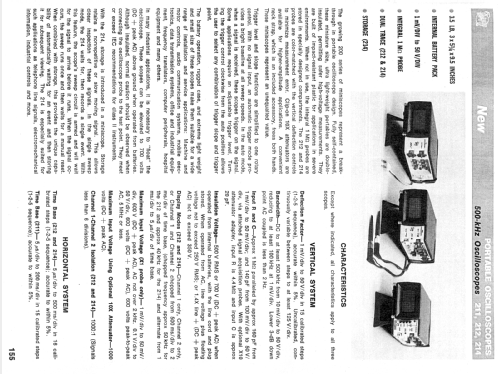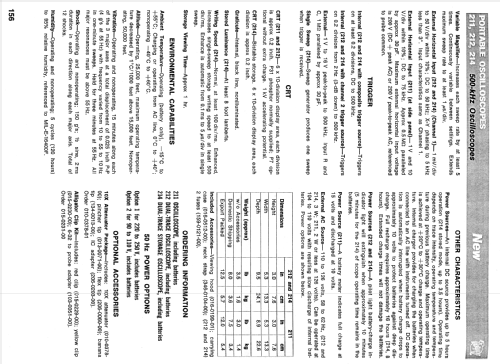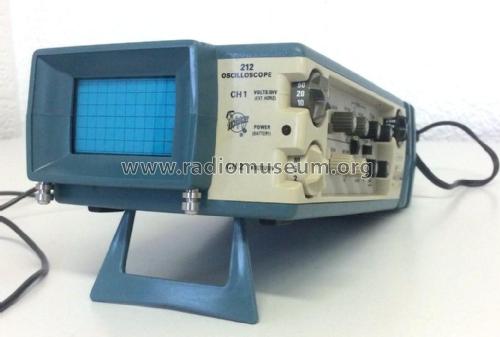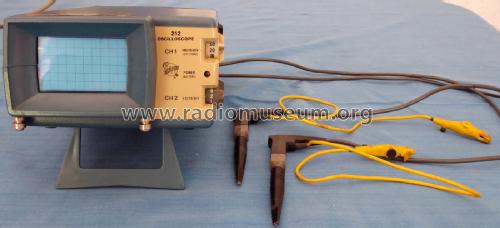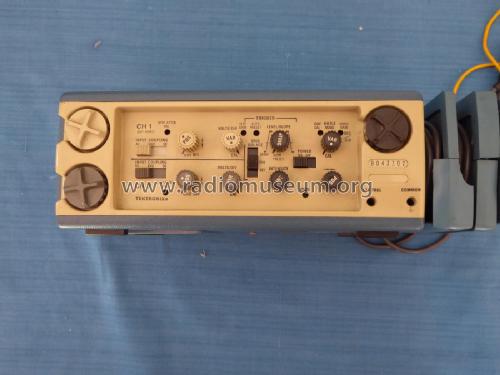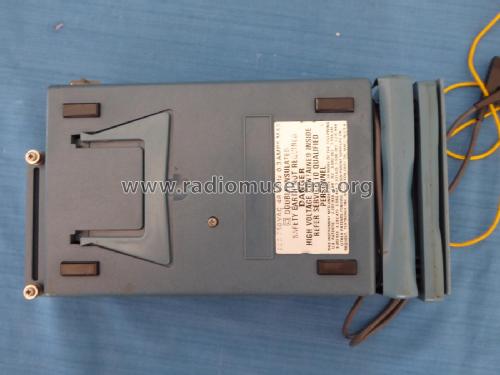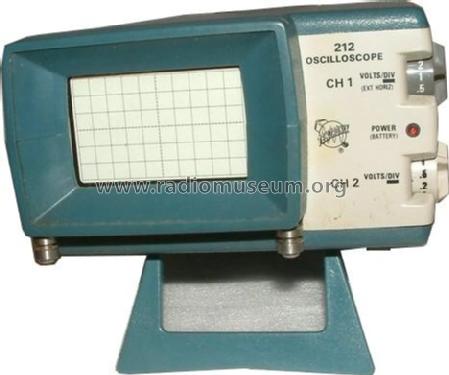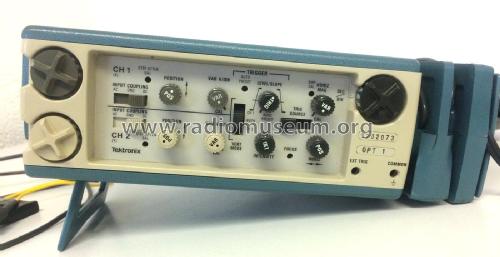Oscilloscope 212
Tektronix; Portland, OR
- País
- Estados Unidos
- Fabricante / Marca
- Tektronix; Portland, OR
- Año
- 1974

- Categoría
- Aparato de medida y servicio (Equipo de laboratorio).
- Radiomuseum.org ID
- 271111
Haga clic en la miniatura esquemática para solicitarlo como documento gratuito.
- Numero de valvulas
- 1
- Válvulas
- Numero de transistores
- Hay semiconductores.
- Semiconductores
- Gama de ondas
- - no hay
- Tensión de funcionamiento
- Red / Acumuladores (posiblemente también baterias) / 48 to 52 or 58 to 62 Hz; 90 to 110 or 110 to 126 or 220 to 250 / internal DC 12 Volt
- Altavoz
- - - No hay salida de sonido.
- Material
- Plástico moderno (Nunca bakelita o catalina)
- de Radiomuseum.org
- Modelo: Oscilloscope 212 - Tektronix; Portland, OR
- Forma
- Portátil > 20 cm (sin la necesidad de una red)
- Ancho, altura, profundidad
- 5.3 x 3 x 9.5 inch / 135 x 76 x 241 mm
- Anotaciones
-
The 212 Oscilloscope is a dual-channel portable oscilloscope using all solid state and integrated circuitry.
The 500 kilohertz vertical system provides vertical deflection factors from one millivolt (at a reduced bandwidth) to 50 volts/division at the tip of either of the two integral high-impedance probes.
Test leads with probes permanently connected to the instrument.
Power options:
Option 1 for 48 to 52 Hz, 220 to 250 V, includes batteries
Option 2 for 48 to 52 Hz, 90 to 110 V, includes batteriesNATO stock no. NSN 6625-01-061-5519
- Peso neto
- 3.5 lb (3 lb 8 oz) / 1.589 kg
- Precio durante el primer año
- 725.00 USD
- Mencionado en
- - - Manufacturers Literature (Technical Manual No. 9-6625-646-14&P Tektronix)
- Documentación / Esquemas (1)
- - - Manufacturers Literature (Catalog: Tektronix Products 1974, pp.155, 156)
- Autor
- Modelo creado por Horst Meier. Ver en "Modificar Ficha" los participantes posteriores.
- Otros modelos
-
Donde encontrará 388 modelos, 376 con imágenes y 92 con esquemas.
Ir al listado general de Tektronix; Portland, OR
Colecciones
El modelo Oscilloscope es parte de las colecciones de los siguientes miembros.
Contribuciones en el Foro acerca de este modelo: Tektronix; Portland,: Oscilloscope 212
Hilos: 4 | Mensajes: 11
Das Gerät hat keine externe DC Versorgung, sondern lässt sich nur über eine AC Versorgung speisen. Anbei die Beschreibung aus den Verkaufsunterlagen von 1974:
Power Sources
An internal DC source provides up to 5 hour operation (214 stored mode, up to 3.5 hours). Operating time depends on trace intensity, operating temperature and temperature during previous battery charge. Maximum operating time is achieved at +20°C to +30°C charge and operating temperature. Internal charger provides for charging the batteries when connected to an AC line with instruments turned off. DC operation is automatically interrupted when battery charge drops to approximately 10 volts to protect batteries against deep discharge. Full recharge requires approximately 16 hours (214, 8 hours). Extended charge times will not damage the batteries.
Power Sources (212 and 214)
A pilot light battery-charge indicator light will extinguish when approximately 10 minutes (5 minutes for the 214) of scope operating time remains in the batteries.
Power Source (211)
A battery meter indicates full charge at 15 volts and discharged at 10 volts.
External AC Source
110 to 126 volts, 58 to 62 Hz, (212 and 214, 3 W; 211, 2 W or less at 126 volts). Can be operated at 104 to 110 volts with resulting slow discharge of internal batteries.
Pius Steiner, 24.Sep.15
hallo Pius,
Die Typenbezeichnung von jedem Tek findet sich vorne auf der Frontplatte und auf dem Deckel vom Handbuch ebenso.
Wenn jetzt irgenjemand so ein Gerät sieht irgendwo, kommt dann zu rmorg und sucht danach, was tippt der dann wohl ein?
Dual Trace Portable...?
der sucht ein 212 Oscilloscope. Und das soll er dann bitte auch finden.Wie die Verkäufer das in ihren Drucksachen vermarktet haben halte ich für interessant aber in der Reihenfolge der Wichtigkeit ist das Gerät selbst , gefolgt vom Manual, ganz vorne. Und das ist absolut eindeutig. Daher befürworte ich keine Änderung oder Erweiterung davon, das kann man in der der Beschreibung ja unterbringen. Ich denke diese Einträge hier (es könnte noch ähnliche geben) sind einfach dadurch entstanden daß der Ersteller davon das Gerät und Manual selber garnicht besitzt und alles aus einem Verkaufsprospekt abgetippt hat.
Diese Diskussion führt darauf hinaus zu entscheiden ob die Bezeichnung aus einem Verkaufsprospekt richtiger ist als die welche das Gerät auf der Frontplatte und dem Handbuch trägt. Für rmorg ist das eine Grundsatzfrage, solltest du mal dem hohen Rat vorlegen um das eindeutig für alle Geräte festzulegen :)
lG Martin
Martin Mehlhose, 01.Sep.15
hallo Pius,
trag ihn ein :-)
wir können ja bei Gelegenheit mal eine Fotoserie von ihm machen, der 212 steht hier zusammen mit 213 und 221 bereit.
lG Martin
Martin Mehlhose, 31.Aug.15
die Fotos sind Falschfarben.
Es gibt den nicht in grau und schon garnicht mit gelber Seite.
Die Geräte sind Tek-blau und haben eine cremefarbene Seite.
Die Typenbezeichnung lautet:
212 Oscilloscope
Begründung dazu:
Tek hatte ein klares System die Geräte zu bezeichnen.Bei vielen beginnt das mit TYPE, das ist aber optional, gefolgt von der Nummer, gefolgt von der Geräteart:
Oscilloscope (für ein normales Oszilloskop)'
Storage Oscilloscope (für ein Speicheroszilloskop)
Dual Beam Oscilloscope (für ein zweistrahliges Oszilloskop)
Digital Storage Oscilloscope (für ein DSO)
Die Gerätebezeichnung sollte immer identisch mit der sein die jeder Tek auf seiner Frontplatte hat.
So läßt sich das auch am einfachsten recherchieren wenn man nach etwas sucht.
Dual Trace + Portable gab es als Bezeichnung bei Tek nicht.
nette Grüße
M. Mehlhose
Martin Mehlhose, 30.Aug.15
